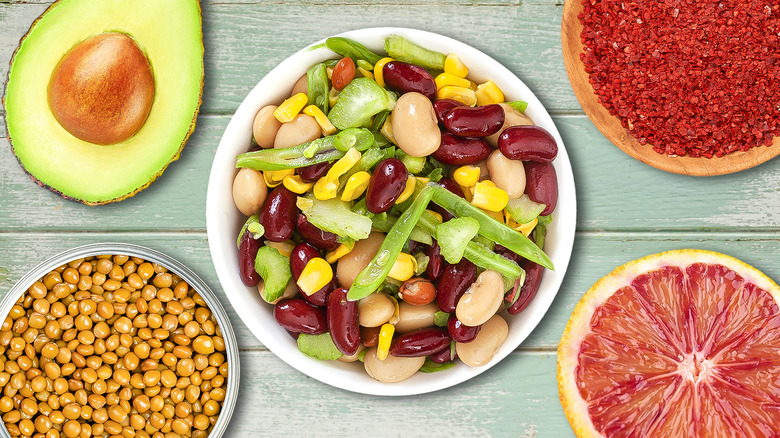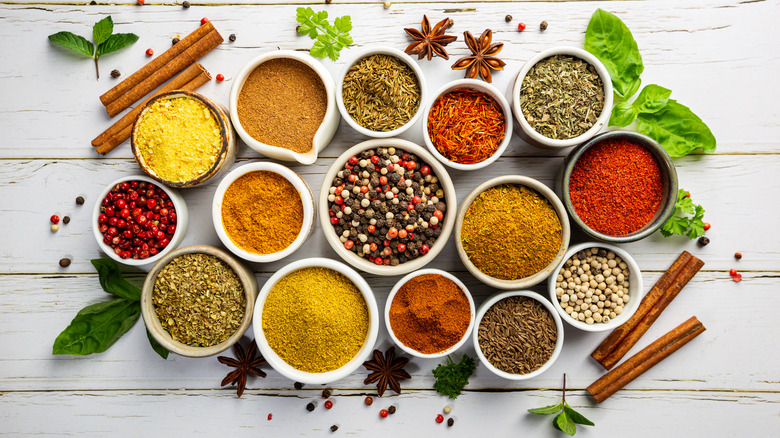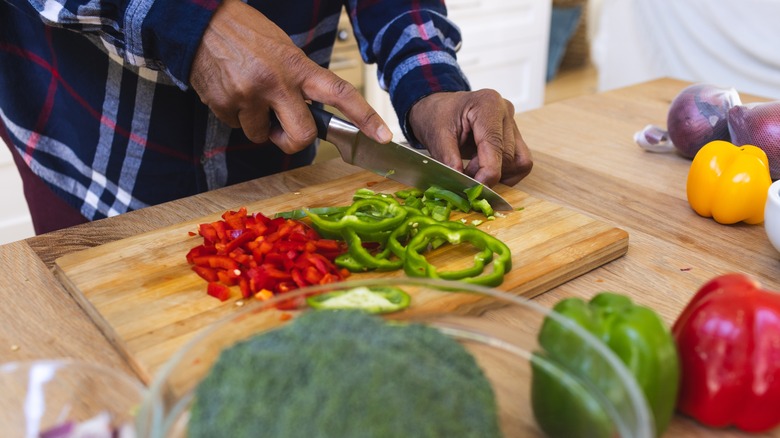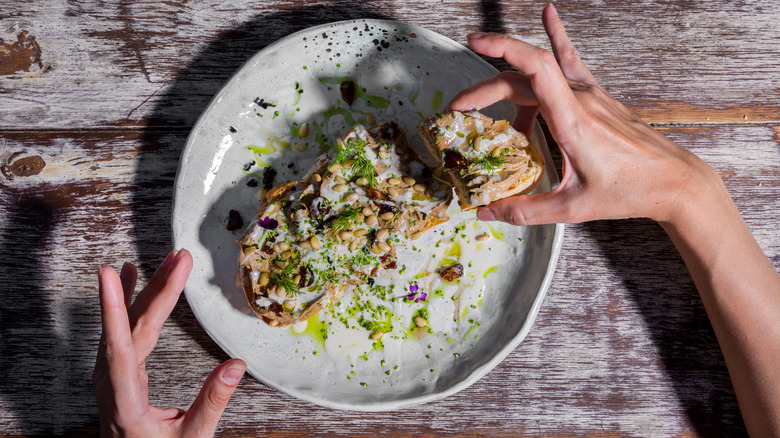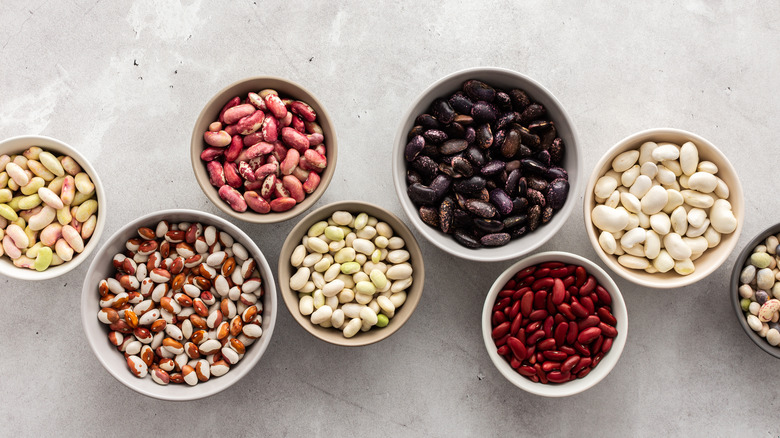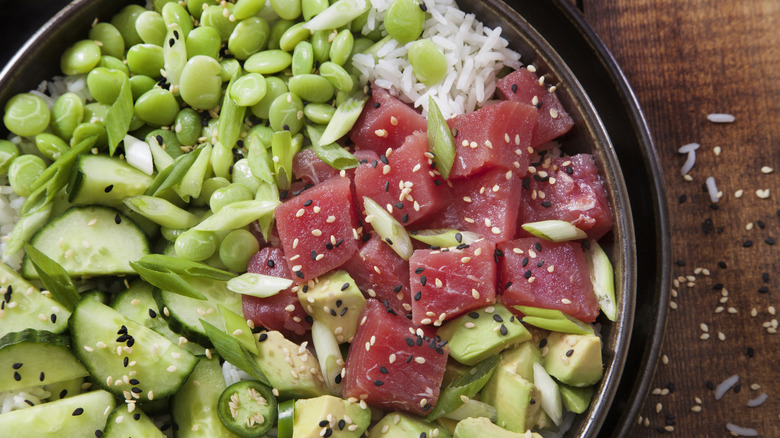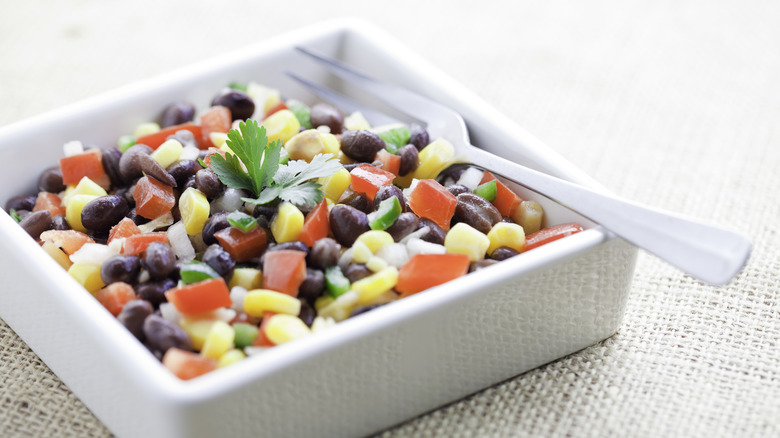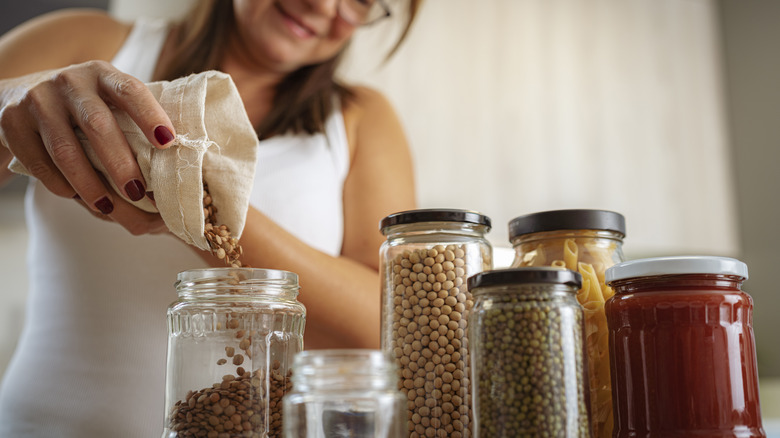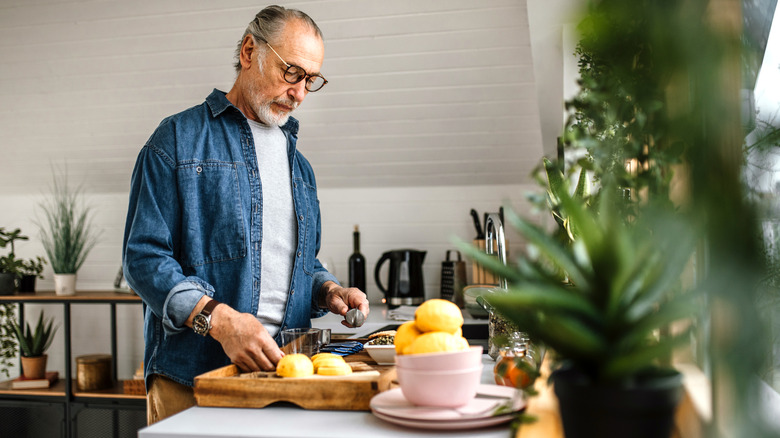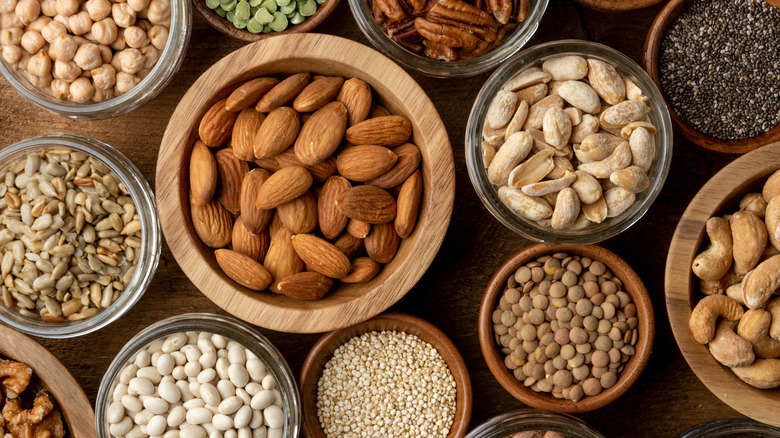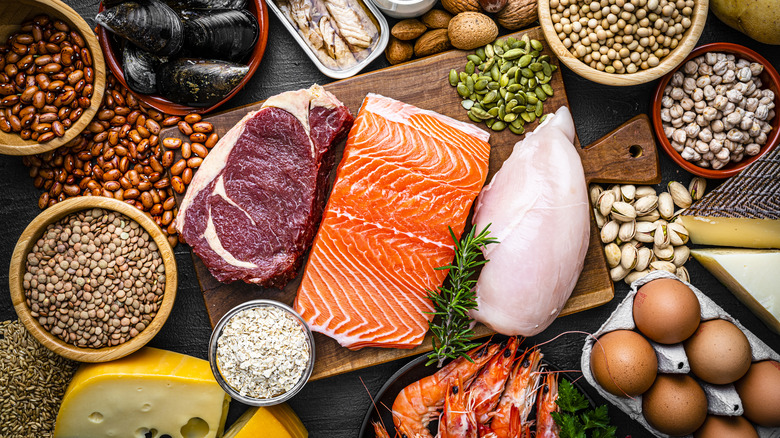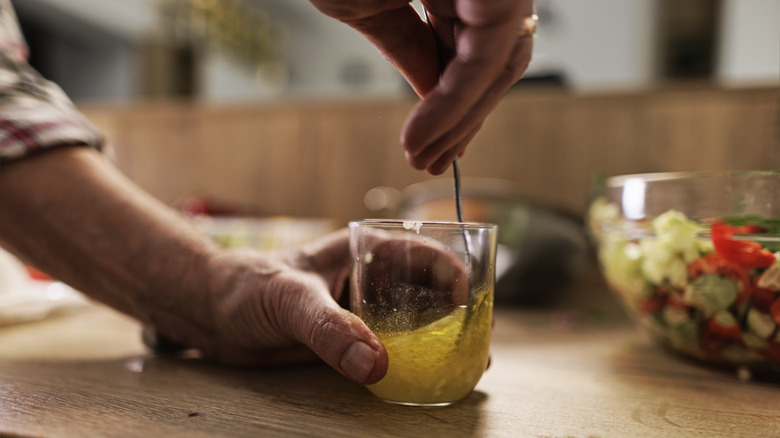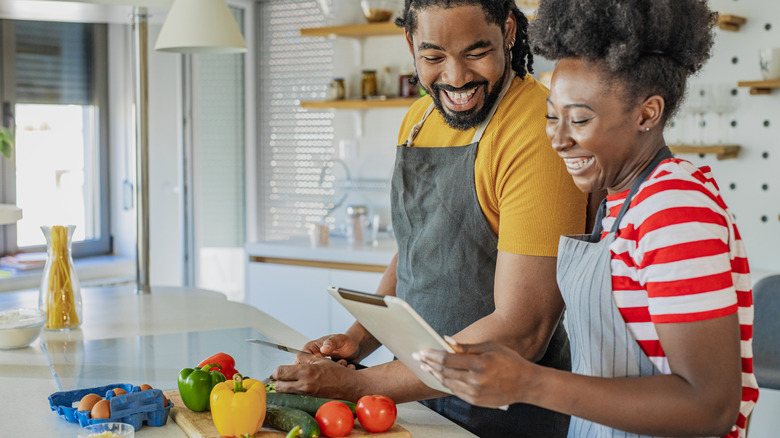12 Ways To Take Bean Salad To The Next Level
No potluck is complete without a bean salad, but bringing a premade, plastic-contained version is akin to a sin. Luckily, though, bean salad is a breeze to make from scratch. Whether you've never made the dish before or have made it the same way your whole life, listen up! We've uncovered 12 tips, tricks, and modifications that will transform your run-of-the-mill bean salad into god-tier bean brilliance.
Contrary to the many drab bean-based dishes, those morsels of fibrous protein can actually be quite exciting. With just a dash of creativity, you can turn a pile of beans into a dish worthy of even the most important gatherings. From healthy and tasty additions to inspiration drawn from other cultures, the steps you can take to revamp your bean salad really have no limit. We're spilling the beans on some of the very best ways to take your bean salad to the next level, and some of these mods may surprise you.
1. Bring on the spice
Almost anything can be upgraded with the right combination of spices, and sometimes the most unexpected of flavors can hit a home run. When it comes to bean salad, adding spices that pack a little heat can transform the staple dish into something fresh on the palate. Ground cayenne pepper, garlic powder, and chili powder are all simple additions you will likely find on your spice rack. Cinnamon and ginger are interesting, heat-laden considerations as well.
A bean salad is a great way to incorporate fresh ingredients in your diet. Throwing in some raw garlic or diced peppers is a great way to achieve this while adding flavor. Use diced or pressed garlic with an oil and vinegar base to maintain a solid, signature flavor throughout the salad. Peppers, on the other hand, come in a vast variety. Bell peppers will have a more subtle flavor while bringing vibrant color to a salad, while jalapeño peppers will have a touch more heat to them. With the inclusion of peppers, you can easily control the level of heat the bean salad receives.
Another fantastic way to incorporate spice into your bean salad is to infuse your choice of vinegar with either raw garlic or spicy peppers. Though this method of boosting flavor is more time-consuming, the result is more subtle than chunks of fresh ingredients. Infusion also ensures the spice is equally distributed throughout the dish.
2. Throw in veggies
Bean salad can be as simple or as complicated as you make it, but the dish certainly has room for plenty of fresh "complications." Foodies with a garden or access to fresh vegetables should utilize the flexibility of bean salad by throwing in everything but the kitchen sink. Fresh green beans are an obvious, yet underused veggie here. If you do add the snappy vegetable (our three bean salad recipe does!), cooking the green beans lightly first will neutralize their hard-to-digest lectins while bringing out their natural flavors.
Other non-bean veggies to add include zucchini, cucumber, avocado, the aforementioned peppers, and halved grape tomatoes. The sky is really the limit here. Feel free to add these veggies any way you'd like, but dicing them into smaller pieces than the beans has some benefits. Smaller veggies keep the focus of bean salad on, well, the beans. There's also an increased chance to get a bite of a little bit of everything when the pieces are chopped into smaller chunks.
One thing to consider when combining a lot of different veggies is texture. Cucumbers are going to come with a crunch, while avocados will typically cube decently but don't have much bite. Mouthfeel contributes to taste, and there should be a medley of textures in a complex bean salad. Consider how each addition will work with the others. You don't want your bean salad to be all crunch or all mush; reach a happy medium with your vegetables.
3. Spread it on bread
Chances are, you've never considered making a bean salad sandwich. The truth is, though, that bread and beans cross paths more than you likely believe. Hummus, made from chickpeas, is often eaten with pita, and baked beans on toast is a popular British dish, especially for breakfast. It goes to reason, then, that bean salad would be killer on top of a slice of rye or sourdough.
Smashing the bean mixture in between two slices of bread is a win, but we can get even more creative with it. Why not spread your bean salad atop a garlic flatbread, maybe with a schmear underneath? Or keep your sandwich open faced with a garnish of sprouts sprinkled on top for good measure? Another unexpected way to lay your beans on something tasty is to make use of crostinis, which is Italian for "little crusts." The crisped slices of baguette offer a buttery crunch that offsets the soft-textured beans beautifully. (Pro tip: Turn your bean salad into a bean bruschetta by adding tomatoes, basil, and feta.)
4. Branch out with a diversity of beans
Bean salad is classically made with a trio of beans, frequently consisting of kidney beans, black beans, and cannellini beans. The truth is, you can use practically any kind of bean or legume to satisfy the "bean" requirement of a bean salad. Beans are just a subcategory of the legumes, but you'll find them to be pretty interchangeable in a salad, and utilizing both has tasty results.
Lentils, chickpeas, and peas are all legumes that fall short of the "bean" title, but they work so well in a bean medley. Not only do they add different flavors and textures into the mix, but they also bring their own special health benefits. All three of the legumes are a wonderful source of protein and fiber. Additionally, chickpeas are a healthy fat, lentils are high in potassium, and peas are laden with antioxidants.
While a bean salad is typically made up of at least three different types of beans, there is no ceiling concerning how many variations you can throw in there. In addition to the standard trio, navy beans, pinto beans, and soybeans are all great choices. Pro tip: Get a bag of the mixed dried beans if you want to take some of the thinking and planning out of putting together a new recipe.
5. Explore different cultures for inspiration
Being a relatively easy crop to grow, beans are utilized all over the world with variations in species from region to region. The accessibility and affordability of beans throughout history and culture have led to some wildly varying bean dishes and styles. While some cultures' legume dishes may be hard to come by in the wild at times, the flavors that accompany them can be recreated.
By utilizing black beans, corn, peppers, and avocado, your bean salad turns into a Mexican-inspired dish. Add mung bean sprouts, edamame, and sesame for a plate that will transport you to Asia — sushi lovers should feel free to throw in some sashimi as well. Bean salad can also take you to the Mediterranean when chickpeas, feta, and sun-dried tomatoes enter the chat.
While ingredients are typically readily available, you may need to source items for your around-the-world bean salad outside of your typical supermarket. Don't fret if Walmart doesn't carry prickly pears, poblano peppers, or jackfruit. Instead, let your taste buds lead you to cultural markets and grocery stores. A lot of cities will have neighborhoods with Latino markets, Asian grocery stores, or the occasional regional restaurant that doubles as a market. Take advantage of these resources, and your culture-inspired bean salad will taste all the more authentic.
6. Let it rest
Some foods just taste better the next day, and bean salad is certainly one dish that is best when left to rest. Allowing your bean salad ingredients some extra time to mingle will result in a tastier dish, as the flavors have more time to meld together. Make this dish a day ahead of time, or make enough to ensure you'll have leftovers to enjoy the next day.
There's actually a scientific reason that leftovers taste so good. Foods heavy in starch can become sweeter as their sugars break down over time, and other foods like garlic and chives oxidize and become even more delicious. This is essentially the same reason why you might want to wait a day or so to eat a freshly made dish. Bean salads can undergo both of these transformations depending on their included ingredients. Bean salads also are vinegar-based, and waiting an extra day or so to consume will allow for the ingredients to marinate.
When resting your bean salad, or storing as leftovers, it's imperative that you do so in the fridge. Bacteria causing foodborne illnesses can grow on food quickly, and the cool temperatures of the fridge slow this process down significantly. We prefer our bean salad without the risk of food poisoning, so keep your food safe to eat by securing it in the fridge!
7. Use dried beans
Bean salad comes with the massive perk of being mostly made from ingredients that are shelf stable. Whether you use canned beans or dried beans, they can stay in your pantry for years. This makes them an ideal backup meal because you can always have the ingredients on hand without having to worry about waste. While canned beans maintain this advantage, there are further benefits to using dried beans.
First of all, dried beans are cheaper. The canned variation isn't going to break the bank, but those pennies add up with each batch of bean salad. The main difference between dried and canned beans is that dried beans also can be seen as healthier. You avoid added salt and exposure to the chemicals that line the inside of cans by purchasing dried beans and soaking them yourself.
It's true that canned beans are more convenient. Dried beans can take hours to soak and cook, so you'll need to plan ahead if you go this route. Sometimes the extra effort is worth it, though, and unless you're in a pinch, dried beans are the way to go.
8. Mix in citrus
Another way to ramp up the quality and flavor profile of your bean salad is to use citrus. There are many ways to do this, from including chunks of mandarins or grapefruit in the mix of beans or adding lemon, lime, or clementine juice to the dressing. Utilizing citrus in your bean salad creates a light, fresh meal with each bite containing its signature flavor. Taste aside, citrus also adds vitamins and beneficial flavonoids to your diet, making a citrus bean salad a powerhouse dish.
If you are in the practice of seasonal eating, then citrus aligns perfectly with a bean salad summer. Squeezing a freshly picked lemon or grapefruit into your bean salad will add a tartness to compliment sweeter ingredients. Opting for an orange or tangerine, on the other hand, will add this sweetness in a dish lacking it.
Don't worry, though. We're not trying to turn your bean salad into a fruit salad. The citrus taste can be subtle. If you're curious and want to experiment with citrus, stick to a simple zest. Instead of incorporating the most-sought-after part of the fruit — its juice — simply shave off a bit of rind over the dish. This allows for tiny sprays to fall over the salad as well as the shavings, transferring a subtle flavor.
9. Up the crunch factor
We've already established how important texture is in regards to taste, and the perfect foil for bean salad's malleable texture is a bit of crunch. Adding a bit of a textural bite will help break up the monotony of the dish and create a more diverse mouthfeel. Throwing in some nuts is a simple and effective way to do this. Candied pecans are on the harder and sweeter side, while sliced almonds will give the salad a more mild crunch and taste. Allergic to nuts? Add crunchy noodle bits or crispy fried onions.
Another way to up the crunch factor without actually adding another ingredient to your bean salad is to crisp the beans in a pan. This will give the beans a bit of a crunchy outlet layer, and doing so avoids one of the biggest mistakes people make with bean salad — dressing your bean salad cold. Crisping the beans before putting the final touches on the dish will not only add that texture we're looking for here but also increase the flavor.
10. Add meat
Bean salad is a fantastic dish for vegetarians and vegans because it's packed with protein. A half cup of beans is the protein equivalent of about an ounce of meat, so while bean salad isn't a steak replacement, it's up there. Instead, bean salad is a great snack or side dish. For those omnivores out there, though, adding meat can turn bean salad into a pretty substantial meal. Portobello mushrooms are a great meat alternative for vegans who want to upgrade their bean salad to a full meal.
Chicken could pair with bean salad nicely, especially if you'd like to keep the meal light. Salmon is an interesting, yet tasty addition. Pairing the meats with veggies like spinach and cucumbers will balance the flavors nicely, and a pesto sauce wouldn't be too shabby. For heavier bean salads, try bacon, ham, or even steak. The heavier you go with your meat options, though, the less your new dish will resemble a traditional bean salad.
Adding meat also comes with a very noticeable taste and texture change. If you want to maintain the scoopability of a bean salad, go for flaky fish or meats cut in small, mixable pieces.
11. Make your own dressing
Making your own dressing comes with a lot of perks, and we're not just talking about avoiding the overwhelming number of choices presented by the wall of dressing in aisle three. Creating a dressing from scratch is more cost-effective, plus you'll know exactly what is in the food you are consuming. It really doesn't take long to mix up your own dressing, and you'll notice the difference in taste, too.
Honestly, a solid base for your bean salad could be simply oil and vinegar, especially if you take the time to infuse them with an additional flavor. The great thing about vinaigrettes, though, is that a wide range of flavors can be used to make them. You've got dressing staples like fruit and herbs, but you can also use unexpected flavors to great effect. Mustard, for instance, makes a great match for vinegar. Walnut oil is a nearly unheard-of option that gives bean salad an earthy and nutty flavor when used in a vinaigrette.
One ingredient that many forget when making their own dressing is sugar, and the addition makes all the difference. Almost all store-bought vinaigrettes are going to be loaded with sugar, so don't feel bad about adding a bit of your own! Sprinkling some sugar in your dressing can help balance out some of the harsher notes. Swap sugar out for honey or agave syrup for slightly different sweet flavors.
12. Flavor match dressing with other ingredients
When experimenting with your own bean salad recipe, there are a lot of variables to consider. Your choice of bean, any added vegetables or meat, and any special touch you may include like spices all affect the flavor profile. It's vital that you factor in these flavors when considering what base dressing you'll be using. After all, the dressing is what will be connecting each ingredient, tying the entire dish together.
The vast majority of bean salads are going to have a vinaigrette base, and the untold truth of vinegar is that there are actually so many kinds available. Apple cider, balsamic, red wine, or white wine vinegar are all popular options for dressings, each with its own flavor profile. If you're making a more simplistic bean salad, using balsamic vinegar will give the dish a more distinct flavor without fighting ingredients. Use apple cider vinegar for bean salads with avocado, apple slices, and walnuts.
Though a vinaigrette is a popular base for bean salads, it's not like the dish is exclusive with the dressing. If you're crafting a bean salad that is already quite packed with flavor, you may want to opt for oil and skip the vinegar all together. Squeeze a lime or lemon over the dish, or infuse the oil with garlic, rosemary, or citrus to create dimension. Bean salad is about creative choices; let the ingredients lead you when deciding on a base.
